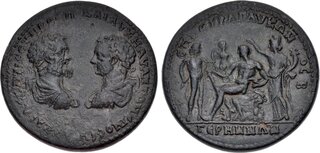| Classical Numismatic Group > Triton XXVII | Auction date: 9 January 2024 |
| Lot number: 468 Price realized: 5,500 USD (Approx. 5,037 EUR) Note: Prices do not include buyer's fees. | Show similar lots on CoinArchives Find similar lots in upcoming auctions on |
| Lot description: LYDIA, Germe. Septimius Severus, with Caracalla. AD 193-211. Æ Medallion (45mm, 48.30 g, 6h). Glykon II, strategos. Struck AD 202-205. AV KAI Λ CЄΠTI CЄYHPOC Π KAI AY K M AY ANTΩNЄINOC ЄY, laureate, draped and cuirassed bust of Septimius Severus right, seen from behind vis-à-vis laureate, draped and cuirassed bust of Caracalla left, seen from behind / ЄΠI CTPA ΓΛYKΩNOC B ΓЄPMHNΩN, at center; Hercules seated left on rock draped with lion's skin, right hand resting on club, holding cantharus in left hand; to right, Apollo stands facing, head right, holding plectrum and lyre; to right, Tyche stands left, wearing calathus, holding cornucopia in right and crowning Hercules with wreath in left; behind Hercules, Artemis standing right, drawing arrow from quiver at shoulder. Ehling 160 (V1/R1); SNG BN 986. Green-black patina, slight roughness. Good VF. Extremely rare, one of five known. Ex Classical Numismatic Group 72 (14 June 2006), lot 1167; Garth R. Drewry Collection (Triton VIII, 11-12 January 2005), lot 765; Classical Numismatic Group 42 (29 May 1997), lot 992; Gorny & Mosch 64 (11 October 1993), lot 547 . This coin can be more closely dated by the magistrate's office. Glykon appears as strategos for the first time earlier in the Severan period; he appears on a coin of Germe in the name of Plautilla, hence 202-205 AD. He must have accepted his second magistracy in the period 205-209 AD, since it is recorded on a coin of Geta as Caesar. The rather crowded reverse features deities that appear individually on numerous Germe coins in the 2nd and 3rd centuries, but not in this grouping, the significance of which is uncertain. We cannot say for sure if reference is being made to a specific event, but the posture of Tyche presenting a wreath to a seated figure (or being presented one herself) is often associated with the sponsoring of agonistic games proclaimed by the emperor and eagerly sought by ambitious towns for the prestige (and income) that the city derived from the affairs. On the other hand, the city fathers would be tapped for hefty contributions toward expenses, often leaving individual magistrates like Glykon bankrupt! He at least got his name on the coin. Germe may have celebrated such a festival, which perhaps coincided with the elevation of Severus' younger son Geta to the rank of Augustus. The problem with this theory, though, is that there are no games issues struck during the Severan era at Germe. There are, however, multiple procession scenes possibly depicting an imperial visit. Estimate: 5000 USD |  |



